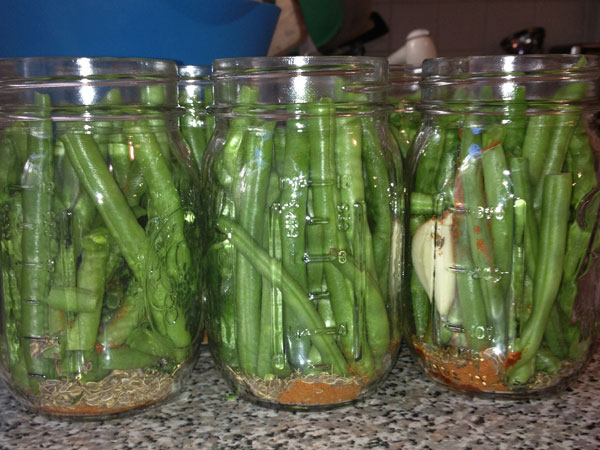I Tried It: Pickling Green Beans the Food in Jars Way
A few weeks ago, I spent some time in Maine, where I ate way too much lobster and blueberry pie. Hoping to detox from the decadence one afternoon, I stumbled into a pub looking for a salad. Skimming the menu, the phrase “dilly beans” popped out at me. Funny name, I thought before asking the server what on earth was in this appetizer. Dilly beans, she told me, are pickled green beans. The sounded like a healthier alternative to the French fries that were beckoning from further down the menu, so I ordered them. Delish! Crunchy and salty and compulsively snack-able, I knew I’d want to try making some as soon as I got home.
Fortunately, when I returned to the office, Food in Jars, the new book from local canning blogger Marisa McClellan was waiting for me—with a recipe for dilly beans. I whipped up a batch in my kitchen last weekend. Here’s how it went.
First, like any good kitchen scientist, I gathered my materials. I’d previously canned tomatoes with a friend—though she did most of the work and I mostly just peeled and seeded until my hands turned red—so I had some jars and lids as well as a large canning pot with a rack. I also had cayenne pepper and vinegar in my pantry, and a fresh garlic bulb, which I’d picked up for 40 cents at the Fairmount Avenue farmers’ market. For the rest of my supplies, I headed down to the Italian Market, where I scored two pounds of green beans for two bucks, a bag full of dill seed for $1.50 from the Spice Corner, and pickling salt from Fante’s for $3.50. (Special thanks to Marisa, who responded to my Twitter question about where to find pickling salt. Fante’s is the only place in the city to score a bag. Wegmans also has it, if you’re willing to travel to the ‘burbs or Cherry Hill.)
Then I sanitized my jars by soaking them for 10 minutes in a boiling water bath. This is a process that caused me a lot of anxiety for a few reasons. First, I was terrified that I’d do something wrong and accidentally make someone sick. Second, I’d forgotten to buy canning tongs to help get the slippery glass jars out of the boiling water. Pro tip: Regular grill tongs wrapped in rubber bands will work just fine. I also put the lids of the jars into a pot of warm, but not boiling, water to soften the sealant.
While all that was happening, I prepared the beans by snipping them down to jar-size. (I was not especially good at this and wound up doing a lot of trimming later. I’ll definitely be more precise next time.) I also used this time to prepare the brine, which was made of pickling salt, vinegar and water.
Then, I put the beans, garlic and spices in the jars. I found that I had more than enough for four jars and wound up sanitizing another jar. (Spoiler alert: This was a mistake. Keep reading to find out why I should’ve just saved the extras for a side dish.)
Then, I poured the brine over the beans, making sure to leave half an inch of space between the liquid and the top of the jar. (This is known as head space. Canning terminology 101!) I used this nifty canning funnel that my mom bought me for Christmas, but you can absolutely get away without it if you’re new to preserving and don’t want to invest in supplies yet. Because I added a fifth jar, I needed to whip up extra brine, which required me to do tricky kitchen math. (Nope, not the reason I should’ve skipped it. Keep reading.)
Then I ran a knife around the edge of each jar to remove air bubbles. I then placed the lids on the jars and dumped them into the canning pot for processing. (Important to note: Your processing time doesn’t begin until the water has returned to a rolling boil.)
About two minutes into the process, I heard a crack in my pot. When I rushed over I found that the bottom of my fifth jar had come clean off. There were dill seeds and cayenne pepper everywhere!
I fished the broken jar out to investigate and let the other beans continue to process. I’m still not entirely sure what went wrong—canning experts, please weigh in!—but I’m chalking it up to bad decision-making skills or a very old jar.
A few minutes later, my beans were done. I scooped them out of the pot and set them on the counter to cool down. Shortly after that, I heard the satisfying pop! of the lids sealing successfully. I can eat my beans in two weeks (though I am tempted to keep one jar around a bit longer to see how the flavor develops).

Despite my exploded jar, I maintain that pickling is an awfully easy and cheap way to make healthy snacks. (And these were pretty quick, too!) I’ve got my eye on some other recipes from Food in Jars and look forward to testing them out later this summer.
See Marisa McClellan’s recipes for Dilly Beans on her blog, also named Food in Jars.



